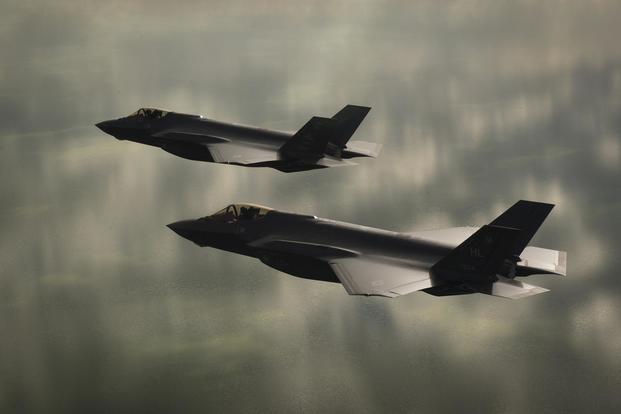The cost to sustain the F-35 Joint Strike Fighter may balloon in the next 15 years, and the Pentagon needs to come up with a plan -- fast -- before it's faced with the choice of buying fewer stealth jets or flying them less often, according to a new watchdog study.
The new assessment from the Government Accountability Office found that the cost to operate and maintain the jet will grow to the point where the services may not be able to afford them.
"Since 2012, F-35 estimated sustainment costs over its 66-year life cycle have increased steadily, from $1.11 trillion to $1.27 trillion, despite efforts to reduce costs," the GAO said in its analysis, released Wednesday. The program's life cycle cost amounts to more than $1.7 trillion, the report states.
Sustainment includes the personnel needed to work on the jet, support equipment, training and other related expenses.
The GAO estimated that the cost to sustain the aircraft will be $6 billion more annually by 2036 than the Pentagon projects it will be able to afford.
Read Next: No 'Mission Accomplished' Moment: Biden Plans to End Afghan War with No Fanfare
Between the Air Force, Marine Corps and Navy, the services want to buy 2,456 of the fifth-generation aircraft for about $400 billion, according to the GAO, although the Pentagon plans to trim that to 2,443.
The Air Force would feel the brunt of the $6 billion price tag, with a total cost gap of $4.4 billion, according to a chart accompanying the report. That's because the service is the largest buyer, with 1,763 F-35A models anticipated to join its inventory.
In May, CNN reported that some Air Force officials had expressed a desire to cap the total number of F-35s the service buys, stopping at 800 of the conventional takeoff and landing A-variant to make room for future fighters.
The GAO confirmed that analysis.
"Air Force officials told us that the Air Force will not be able to afford the cost of sustaining the 1,763 aircraft it plans to purchase without making dramatic cuts to sustainment costs of the F35," the report states.
While "officials stressed that there is no single solution" to solving the cost problem, reducing its inventory would help; another alternative would be to fly the aircraft less, the GAO said.
Each of the services, the GAO report argued, should strive to reduce its cost per aircraft annually: $3.7 million per airplane for the Air Force; $2.3 million for the Marine Corps' F-35B short vertical and takeoff landing variant; $1.1 million for the Marine Corps' F-35C carrier-capable variant; and $2.4 million for the Navy's F-35C.
Lawmakers in recent months have also scrutinized the jet's sustainment, maintenance and supply chain management because of overspending.
In March, Rep. Adam Smith, D-Wash., chairman of the House Armed Services Committee, dubbed the F-35 a "rathole," saying the government is spending way beyond its means for one Pentagon program.
"What does the F-35 give us?" Smith said during a Brookings Institution event. "Is there a way to cut our losses? Is there a way to not keep spending so much money for such a low capability? Because the sustainment costs are brutal."
A longtime military aviation specialist, who asked not to be identified because he is not authorized to speak to the press in his current job, said that while the report should give the services pause, it is only a prediction.
"Yes, the sustainment costs for the F-35 are projected to be very high," the specialist said. "[However], this is a very unusual number -- it's the first time we've tried to project the costs of a whole fleet over its entire lifetime.
"If you had projected the costs of [thousands of F-16 Fighting Falcons] for 40 years back when that program started, it would've been a pretty staggering number as well," the specialist said.
David Deptula, a retired Air Force lieutenant general and dean of the Mitchell Institute, said the focus from government agencies should also take into account how the jet is used and whether there are alternatives to meet the same objectives.
"What does it take in terms of alternatives to accomplish the same effects that can be accomplished by the F-35?" Deptula said in an email. "If it takes two or more other systems at an equivalent or even lesser cost, then the F-35 is more cost-effective and is the better choice."
The watchdog recommends that the Pentagon devise a plan to implement cost reduction measures before moving into full-rate production.
In a statement, the F-35's Joint Program Office, or JPO, said it agrees with many of the GAO's findings and understands that the U.S. military, international partners and foreign military sale customers don't have "unlimited funds" to maintain the program.
But the GAO's estimates do not take into account recent changes such as the expected service life of the aircraft, the office said.
The JPO says current plans call to retire the aircraft in 2064, but the GAO said it expects the Defense Department to fly the aircraft into 2077 -- adding 13 years onto the program, a crucial factor for increased sustainment costs.
The specialist said the report does not automatically mean that the services will start axing their aircraft purchases, even though the Air Force has already been considering a 10% cut in F-35 buys over the next five years, according to Air Force Magazine, citing a growing need to buy the most up-to-date jets and upgrade others as they become available.
Purchasing fewer F-35s "depends on who has the most influence on the decision-makers," Deptula said. "The accountants or warfighters?"
-- Oriana Pawlyk can be reached at oriana.pawlyk@military.com. Follow her on Twitter at @Oriana0214.
Related: Marine Corps' First Carrier-Capable F-35 Squadron Is Ready for Wartime Use















